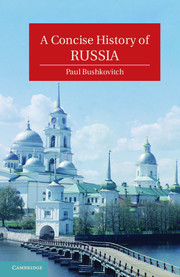Book contents
- Frontmatter
- Contents
- List of Figures
- Abbreviations
- Acknowledgments
- Prologue
- 1 Russia before Russia
- 2 Moscow, Novgorod, Lithuania, and the Mongols
- 3 The Emergence of Russia
- 4 Consolidation and Revolt
- 5 Peter the Great
- 6 Two Empresses
- 7 Catherine the Great
- 8 Russia in the Age of Revolution
- 9 The Pinnacle of Autocracy
- 10 Culture and Autocracy
- 11 The Era of the Great Reforms
- 12 From Serfdom to Nascent Capitalism
- 13 The Golden Age of Russian Culture
- 14 Russia as an Empire
- 15 Autocracy in Decline
- 16 War and Revolution
- 17 Compromise and Preparation
- 18 Revolutions in Russian Culture
- 19 Building Utopia
- 20 War
- 21 Growth, Consolidation, and Stagnation
- 22 Soviet Culture
- 23 The Cold War
- Epilogue
- Further Reading
- Index
1 - Russia before Russia
Published online by Cambridge University Press: 05 June 2012
- Frontmatter
- Contents
- List of Figures
- Abbreviations
- Acknowledgments
- Prologue
- 1 Russia before Russia
- 2 Moscow, Novgorod, Lithuania, and the Mongols
- 3 The Emergence of Russia
- 4 Consolidation and Revolt
- 5 Peter the Great
- 6 Two Empresses
- 7 Catherine the Great
- 8 Russia in the Age of Revolution
- 9 The Pinnacle of Autocracy
- 10 Culture and Autocracy
- 11 The Era of the Great Reforms
- 12 From Serfdom to Nascent Capitalism
- 13 The Golden Age of Russian Culture
- 14 Russia as an Empire
- 15 Autocracy in Decline
- 16 War and Revolution
- 17 Compromise and Preparation
- 18 Revolutions in Russian Culture
- 19 Building Utopia
- 20 War
- 21 Growth, Consolidation, and Stagnation
- 22 Soviet Culture
- 23 The Cold War
- Epilogue
- Further Reading
- Index
Summary
Russian history begins with the polity that scholars have come to call Kiev Rus, the ancestor of modern Russia. Rus was the name that the inhabitants gave to themselves and their land, and Kiev was its capital. In modern terms, it embraced all of Belarus, the northern half of the Ukraine, and the center and northwest of European Russia. The peoples of these three modern states are the Eastern Slavs, who all speak closely related languages derived from the East Slavic language of Kiev Rus. In the west its neighbors were roughly the same as the neighbors of those three states today: Hungary, Poland, the Baltic peoples, and Finland. In the north Kiev Rus stretched toward the Arctic Ocean, with Slavic farmers only beginning to move into the far north.
Beyond the Slavs to the east was Volga Bulgaria, a small Turkic Islamic state that came into being in about AD 950 where modern Tatarstan stands today. Beyond Volga Bulgaria were the Urals and Siberia, vast forests and plains inhabited by small tribes who lived by hunting and gathering food. The core of Kiev Rus was along the route that ran from northern Novgorod south to Kiev along the main rivers. There in the area of richest soil lay the capital, Kiev. Even farther to the south of Kiev began the steppe.
- Type
- Chapter
- Information
- A Concise History of Russia , pp. 1 - 18Publisher: Cambridge University PressPrint publication year: 2011

